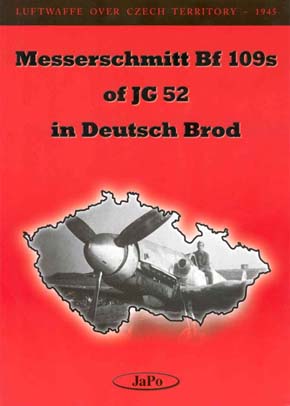JaPo | Messerschmitt Bf 109s of JG 52 In Deutsch Brod
Reviewed by Mark Proulx

Soft
Cover
56 Pages
8 ¼ x 11 ½
This is a review of the new book from JaPo detailing the Bf 109's of JG 52 based at Deutsch Brod at the end of WW II. The authors, Ales Janda and Tomas Poruba closely examine six different 109s that were photographed at the Czech airfield. They make use of many previously un-published photographs to support the colourful side profiles.
The first aircraft is "Yellow 11", a Bf 109 G-14/U4 of 3./JG 52. The werk number is unknown. The aircraft is finished in a pattern of RLM 75/76/83.
Next is "Black 7", W. Nr. 786476, a Bf 109G-14/AS of 2./JG 52. The May 1945 scheme is RLM 75/76/81/83.
"Yellow 6" is a Bf 109G-14/AS from 11./JG 52. The W. Nr. Is only partially known. It is finished in the late war colors of RLM 75/76/81/83.
"Yellow 9" is a Bf 109G-10/U4 from 11./JG 52. This aircraft is finished RLM 75/76/83 with the RLM 75 shade being lighter than normal. The aircraft also has a werk number that is only partially known.
The fifth aircraft is a Bf 109K-4 of Stab III./ JG 53. The werk number is unknown but may be from the 335XXX production block. The late war colors of RLM 75/76/81/83 were applied. The aircraft was previously identified as "Black 4" and is reported to have been flown by 132-victory ace Hptm. Adolf Borchers.
The final aircraft is a very interesting Bf 109G-10/R6. It is dealt with at the end of the book, as the research is incomplete. "Yellow 11" is assumed to be from the Erla Liepzig production run in the 152XXX werk number range. It is an interesting scheme of solid RLM 83 on the upper surfaces over the standard lower color of RLM 76. The assignment to JG 52 also remains to be confirmed.
Modelers and historians alike will appreciate the superb color profiles of each aircraft. Both left and right sides are shown in complete color. However, some speculation was required to complete the schemes as stated in the text. Top and bottom views are also included, printed in black and white. This will be very helpful for determining how to apply the camouflage patterns. Stencilling information is also provided for each of the subject aircraft. Using text, the authors proceed to scrutinize in the smallest detail the camouflage of each aircraft and the rational as to what makes up each of these subtypes. Tomas Poruba did the color profiles with Jaroslav Farkas. In my opinion, the profiles are among the best currently available.

Also included is an established loss data for Stab, I and III./JG 52 for the last year of the war. This information is always helpful as there is still much to learn about the Luftwaffe in the closing stages of the conflict. Other details include a brief history of Deutsch Brod airfield and the role it played in the war.
The books from JaPo never fail to impress me with their quality artwork and magnitude of un-published photos. A quick look at the JaPo Website indicates a number of titles are already sold out. I am sure this one will follow suit. Individuals with an interest in late war German aircraft should consider having this book as part of their reference library. I am confident that you will not be disappointed.
© Mark Proulx 2004
This review was published on Saturday, July 02 2011; Last modified on Wednesday, May 18 2016
